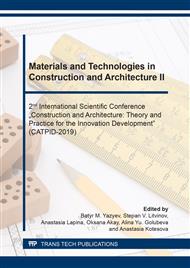[1]
O.M. Safina, Road vibropressed concrete products with improved performance, (2002).
Google Scholar
[2]
G.I. Nadykto, V.S. Prokopets, Road asphalt, Tutorial SibADI, (2009).
Google Scholar
[3]
I.S. Ischenko, Technology of device and repair of asphalt concrete pavements, Air-Art, (2001).
Google Scholar
[4]
V.V. Ershov, The use of the PPP mechanism for the implementation of programs to improve the efficiency of energy saving in housing and public utilities. In the book: Economics, Ecology and Society of Russia in the 21st century, a collection of scientific papers of the 18th International Scientific and Practical Conference. (2016) 255-258.
Google Scholar
[5]
N.B. Kolosova, Problems of modern concrete and reinforced concrete, Engineering and Construction Journal. 8 (26) (2011) 4.
Google Scholar
[6]
Yu.B. Kostikov, Recommendations on the use of paving in the device coverage of residential and public business buildings, SPB Mayor's Office, (2016).
Google Scholar
[7]
I.V. Kulish, N.B. Kolosova, V.V. Ershov, Selection of the optimal variant of pavement coverings in the residential and public-business development zone. In the collection: SPbPU Science Week. Materials of a scientific conference with international participation. Civil Engineering Institute. (2018) 195-197.
Google Scholar
[8]
S.A. Stelmakh, E.M. Shcherban, O.A. Zholobova, Prescription and technological aspects of manufacturing high-quality centrifuged products and structures from heavy concrete, IOP Conference Series: Materials Science and Engineering. 463 (2018).
DOI: 10.1088/1757-899x/463/2/022056
Google Scholar
[9]
A.A. Chernilnik, E.M. Shcherban, S.A. Stelmakh, S.V. Cheburakov, D.M. Elshaeva, N.A. Dotsenko, Setting and technological aspects of obtaining high-quality centrifuged concrete, Engineering journal of Don. 1 (2019).
Google Scholar
[10]
E.M. Shcherban, S.A. Stelmakh, M.P. Nazhuev, A.S. Nasevich, V.E. Geraskina, A.B. Poshev, The effect of various types of fibers on the physical mechanical properties of centrifuged concrete, The Eurasian scientific journal. 6 (2018).
Google Scholar
[11]
V.G. Pashkovskiy, Influence of the temperature factor on the cracks formation and development in the CN Supports, Transport Construction. 8 (1964) 45-46.
Google Scholar
[12]
N.V. Mikhaylov, V.G. Pashkovskiy, Problem of longitudinal cracks in centrifuged supports, Electrical construction. 2 (1967) 60−66.
Google Scholar
[13]
V.A. Nevskiy, Prediction of the concrete durability with alternating effects of the environment, Taking into account its structure and deformative properties, Мoscow, (1984).
Google Scholar
[14]
V.A. Nevskiy, Yu.V. Fedorenko, E.I. Lysenko, V.P. Petrov, V.P. Shurygin, Combined aggregates in centrifugal concrete, Transport Construction. 7 (1983) 30-31.
Google Scholar
[15]
V.P. Petrov, E.I. Lysenko, G.A. Tkachenko, V.P. Shurygin, Concrete with combined aggregate in the production of centrifuged contact network poles, Transport Construction. 10 (1983) 32.
Google Scholar
[16]
V.P. Petrov, Technology and properties of centrifuged concrete with the combined aggregate for supports of the contact network, Rostov-on-Don, (1983).
Google Scholar
[17]
Guide for the production of reinforced concrete centrifuged resistant support of contact network and air-lines of automatic block system of concrete combined with a placeholder, Research institute of transport construction, Moscow, (1989).
Google Scholar
[18]
G.A. Tkachenko, V.P. Petrov, E.Yu. Romanenko, High-strength concrete with combined filler for centrifuged catenary supports, Abstracts of scientific and technical conferences, Moscow, (1988) 37-38.
Google Scholar
[19]
V.P. Shurygin, V.A. Nevskiy, G.A. Tkachenko, V.P. Petrov, USSR Certificate of Authorship 1004298. (1983).
Google Scholar
[20]
V.P. Shurygin, G.A. Tkachenko, V.P. Petrov, E.Yu. Romanenko, Crack resistance increase of centrifuged concrete with combined aggregate, Transport Construction. 8 (1988) 33-34.
Google Scholar
[21]
E.Yu. Romanenko, High-strength concretes with mineral porous and fibrous additives for the manufacture of long-length centrifuged structures, Rostov-on-Don, (1989).
Google Scholar
[22]
O.P. Mchedlov-Petrosyan, Modern views on the processes of hardening binders, New technology and technology of cement production, Moscow, (1964).
Google Scholar


